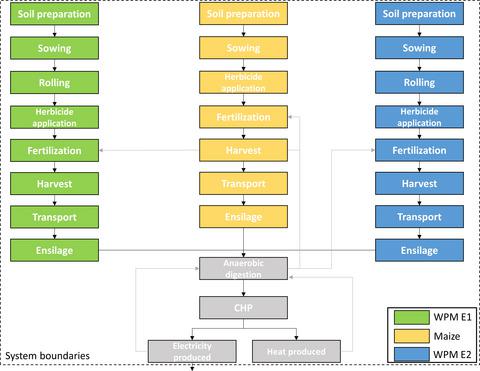当前位置:
X-MOL 学术
›
GCB Bioenergy
›
论文详情
Our official English website, www.x-mol.net, welcomes your feedback! (Note: you will need to create a separate account there.)
Comparative environmental and economic life cycle assessment of biogas production from perennial wild plant mixtures and maize (Zea mays L.) in southwest Germany
Global Change Biology Bioenergy ( IF 5.6 ) Pub Date : 2020-06-27 , DOI: 10.1111/gcbb.12715 Jan Lask 1 , Alejandra Martínez Guajardo 1 , Jan Weik 1 , Moritz Cossel 1 , Iris Lewandowski 1 , Moritz Wagner 1
Global Change Biology Bioenergy ( IF 5.6 ) Pub Date : 2020-06-27 , DOI: 10.1111/gcbb.12715 Jan Lask 1 , Alejandra Martínez Guajardo 1 , Jan Weik 1 , Moritz Cossel 1 , Iris Lewandowski 1 , Moritz Wagner 1
Affiliation

|
Maize silage is the main biogas co‐substrate in Germany, but its use is often questioned due to negative environmental impacts. Perennial wild plant mixtures (WPM) are increasingly considered alternatives, as these extensive systems improve soil quality and enhance agrobiodiversity. Methane yields per hectare however do not match those of maize. This study examined whether the potential advantages of replacing maize with WPM for biogas production are counteracted by lower yields and associated effects. Life cycle assessment and life cycle cost assessment were used to compare the environmental and economic performance of electricity generation from WPM in two establishment procedures, ‘standard’ (WPM E1) and ‘under maize’ (WPM E2). These metrics were benchmarked against those of maize. The production of 1 kWh electricity was chosen as functional unit. The life cycle inventory of the agricultural phase was based on multi‐annual field trials in southwest Germany. Both WPM E1 and E2 had lower marine eutrophication and global warming potentials than maize. The GWP favourability was however sensitive to the assumptions made with regard to the amount and fate of carbon sequestered in the soil. WPM E1 performed less favourable than WPM E2. This was mainly due to lower yields, which could, in turn, result in potential indirect land use impacts. These impacts may outweigh the carbon sequestration benefits of WPM cultivation. Maize performed best in terms of economic costs, freshwater eutrophication, terrestrial acidification, fine particulate matter and ozone formation. We conclude that the widespread deployment of WPM systems on productive agricultural land should only take place if permanent soil carbon sequestration can be ensured. In either case, WPM cultivation could be a valid alternative for bioenergy buffers and marginal land where competitive yields of common crops cannot be guaranteed, but which could accommodate low‐input cultivation systems.
中文翻译:

德国西南部多年生野生植物混合物和玉米(Zea mays L.)沼气生产的环境和经济生命周期比较评估
玉米青贮饲料是德国主要的沼气共底物,但由于负面的环境影响,其使用经常受到质疑。多年生野生植物混合物(WPM)被越来越多地视为替代品,因为这些广泛的系统改善了土壤质量并增强了农业生物多样性。但是,每公顷甲烷的产量与玉米不匹配。这项研究检查了用WPM替代玉米生产沼气的潜在优势是否被较低的产量和相关影响所抵消。生命周期评估和生命周期成本评估用于比较“标准”(WPM E1)和“玉米不足”(WPM E2)这两种建立程序中WPM发电的环境和经济绩效。这些指标以玉米为基准。选择生产1千瓦时的电力作为功能单元。农业阶段的生命周期清单基于德国西南部的多年田间试验。WPM E1和E2的海洋富营养化和全球变暖潜力均低于玉米。但是,全球升温潜能值的好坏对关于固存在土壤中的碳的数量和结局的假设很敏感。WPM E1的表现不如WPM E2好。这主要是由于单产降低,进而可能导致潜在的间接土地使用影响。这些影响可能超过WPM种植的固碳收益。玉米在经济成本,淡水富营养化,陆地酸化,细颗粒物和臭氧形成方面表现最佳。我们得出结论,只有在可以确保永久性固存土壤碳的情况下,才应在生产性农业土地上广泛部署WPM系统。在这两种情况下,WPM种植都可以替代生物能源缓冲带和边际土地,因为这些地方不能保证普通作物的竞争性产量,但可以适应低投入的种植系统。
更新日期:2020-06-27
中文翻译:

德国西南部多年生野生植物混合物和玉米(Zea mays L.)沼气生产的环境和经济生命周期比较评估
玉米青贮饲料是德国主要的沼气共底物,但由于负面的环境影响,其使用经常受到质疑。多年生野生植物混合物(WPM)被越来越多地视为替代品,因为这些广泛的系统改善了土壤质量并增强了农业生物多样性。但是,每公顷甲烷的产量与玉米不匹配。这项研究检查了用WPM替代玉米生产沼气的潜在优势是否被较低的产量和相关影响所抵消。生命周期评估和生命周期成本评估用于比较“标准”(WPM E1)和“玉米不足”(WPM E2)这两种建立程序中WPM发电的环境和经济绩效。这些指标以玉米为基准。选择生产1千瓦时的电力作为功能单元。农业阶段的生命周期清单基于德国西南部的多年田间试验。WPM E1和E2的海洋富营养化和全球变暖潜力均低于玉米。但是,全球升温潜能值的好坏对关于固存在土壤中的碳的数量和结局的假设很敏感。WPM E1的表现不如WPM E2好。这主要是由于单产降低,进而可能导致潜在的间接土地使用影响。这些影响可能超过WPM种植的固碳收益。玉米在经济成本,淡水富营养化,陆地酸化,细颗粒物和臭氧形成方面表现最佳。我们得出结论,只有在可以确保永久性固存土壤碳的情况下,才应在生产性农业土地上广泛部署WPM系统。在这两种情况下,WPM种植都可以替代生物能源缓冲带和边际土地,因为这些地方不能保证普通作物的竞争性产量,但可以适应低投入的种植系统。



























 京公网安备 11010802027423号
京公网安备 11010802027423号